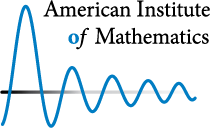2. Ehrhart $h^\ast$-polynomial: Unimodality and Real-Rootedness
-
Problem 2.02.
Does the Pitman-Stanley polytope have real-rooted $h^*$-polynomial?-
Remark. [Alejandro Morales] In unpublished work of (Benedetti-Gonzalez D’Leon-Hanusa-Harris) the \(h^*\) polynomial of the Pitman-Stanley polytope of dimension \(n\) is $h^*(z)=\sum_{\pi \in PF_n} z^{des(\pi)}$, where $PF_n$ is the set of parking functions of size $n$ and $des(\pi)$ is the number of descents of $\pi$ which are the indices $i$ such that $\pi(i)\geq \pi(i+1)$.
-
-
Problem 2.06.
For a lattice polytope $P$, let $P^n$ denote the Cartesian product of $P$ with itself $n$ times ($n\in \N$). Investigate what happens to the $h^*$-polynomial of $P^n$. Does it eventually become real-rooted? -
Problem 2.08.
For a symmetric edge polytope, can we obtain regular unimodular triangulations using liftings with low heights? If so, how many such triangulations can be obtained? -
Problem 2.1.
What are the ways of “measuring” root polytopes, i.e., edge polytopes?
Furthermore, how should Grothendieck polynomials be specialized to obtain Ehrhart $h^*$-polynomials? -
Problem 2.12.
Consider the order polynomial, denoted $\Omega(P,t)$, of a finite poset $P$. Let $n$ be the number of elements in $P$.
Conjecture [Kahn, Saks] $\frac{\Omega(P,t)}{t^n}$ is nonincreasing for all $t\in \Z_{>0}$.
This statement is known to be true if all coefficients of $\Omega(P,t)$ are positive. Investigate the conjecture more generally.
(See solution to Exercise 3.163(b) inEnumerative Combinatorics Vol. 1by Stanley). -
Definition: Let $P$ be a lattice polytope of dimension $d$. Let $\omega\in \Q[x_1,\ldots,x_d]$ be a homogeneous polynomial. We define the $\omega$-Ehrhart function $$i(P;\omega;n) := \sum_{\alpha\in nP\cap \Z^d} \omega(\alpha).$$
Problem 2.14.
Note that $i(P;1;n) = i(P;n)$. It is known that $i(P;\omega;n)$ is a polynomial with leading coefficient given by $\int_P \omega$. Investigate $\omega$-Ehrhart function for well-known classes of polytopes. -
Problem 2.16.
Identify polytopes with extremal $h^*$-vectors. That is, for a family of polytopes $\mathcal{P}$ and index $j$, find $P\in \mathcal{P}$ that minimize or maximize $h_j^*$. Potential families of interest include symmetric edge polytopes for a fixed degree sequence and simplices in Hermite normal form with fixed diagonal. -
Problem 2.18.
What relationship, if any, is there between heights of Hilbert basis elements and differences in $h^*$-coefficients? For example, consider $h^*_{j+1} - h^*_j$ or more generally $h^*_j - h^*_i$. -
Problem 2.2.
Take the nonnegative hull of $h^*$-vectors of polytopes in a fixed dimension. Does this form a polyhedral cone? -
Problem 2.22.
Are there “holes” in the set of $h^*$-vectors of polytopes in a fixed dimension which are not a result of failing known linear inequalities? -
Problem 2.26.
Consider the convex hull of parking functions. Does this admit a unimodular triangulation? Furthermore, can the Ehrhart polynomial be obtained from this? -
Problem 2.28.
- (a) Find $0/1$-polytopes with non-unimodal, non-log-concave, etc. $h^*$-vectors.
- (b) Find $0/1$-polytopes with non-unimodal, non-log-concave, etc. $f$-vectors.
- (c) Find $0/\pm1$-polytopes with non-unimodal, non-log-concave, etc. $h^*$-vectors.
-
Problem 2.3.
Determine a Veronese construction for rational polytopes.-
Remark. [Mariel Supina] I want to clarify what I meant with this problem. For lattice polytopes, we can apply a certain transformation to the $h^*$-polynomial of $P$ to get the $h^*$-polynomial of $kP$ for a positive integer $k$ (see e.g. https://arxiv.org/pdf/0712.2645.pdf). Does such a transformation exist for rational polytopes? Does such a transformation exist in the setting of equivariant Ehrhart theory?
-
-
Problem 2.32.
How many chambers are there for transportation polytopes for $n\times n$ matrices? For example, how many Ehrhart polynomials are needed? -
Problem 2.38.
Investigate Stapledon’s Effectiveness Conjecture.
Conjecture. [Stapledon] Let $P$ be a lattice polytope invariant under the action of a group $G$. Then the characters of the equivariant $H^*$-series is effective if and only if the equivariant $H^*$-series is a polynomial.
Stapledon proved that $H^*$ effective implies $H^*$ is a polynomial. The converse remains open. -
Problem 2.4.
A spinal graph $G$ is a connected digraph on vertex set $V=\{1,2,...,n\}$ with edge multiset $E$, where all edges are directed from smaller to larger vertices and $E$ contains all edges of the form $(i,i+1)$ for $i=1,\ldots,n-1$ (i.e., the “spine” of $G$).
What can be said about the $h^*$-polynomials of flow polytopes of spinal graphs?
Conjecture: descent polynomial of lower $G$-permutations $\leq h^*(\mathcal{F}_1;z) \leq $ descent polynomial of upper $G$-permutations, where $\leq$ indicates domination.
Cite this as: AimPL: Ehrhart polynomials: inequalities and extremal constructions, available at http://aimpl.org/ehrhartineq.
